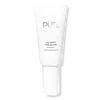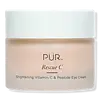What's inside
What's inside
 Key Ingredients
Key Ingredients

 Benefits
Benefits

 Concerns
Concerns

 Ingredients Side-by-side
Ingredients Side-by-side

Water
Skin ConditioningPropanediol
SolventNiacinamide
SmoothingSqualane
EmollientJojoba Esters
EmollientIsoamyl Laurate
EmollientSaccharomyces Ferment
Skin ConditioningGlycerin
HumectantC14-22 Alcohols
Emulsion Stabilising3-O-Ethyl Ascorbic Acid
Skin ConditioningPanthenol
Skin ConditioningSodium Hyaluronate
HumectantCeramide AP
Skin ConditioningRetinol
Skin ConditioningLactic Acid
BufferingButyrospermum Parkii Butter Extract
Skin ConditioningSodium Starch Octenylsuccinate
AbsorbentPanax Quinquefolius Root Extract
AstringentMelia Azadirachta Leaf Extract
Skin ConditioningBrassica Oleracea Acephala Leaf Extract
HumectantSpinacia Oleracea Leaf Extract
Skin ConditioningTriethyl Citrate
MaskingAloe Barbadensis Leaf Juice
Skin ConditioningLavandula Angustifolia Flower/Leaf/Stem Extract
MaskingPunica Granatum Seed Extract
Skin ConditioningRubus Idaeus Fruit Extract
AstringentVaccinium Macrocarpon Seed Oil
Skin ConditioningApium Graveolens Seed Extract
AntioxidantGlucose
HumectantAnanas Sativus Fruit Extract
Skin ConditioningCitrus Limon Peel Extract
EmollientCitrus Paradisi Peel Extract
PerfumingPyrus Malus Fruit Extract
Skin ConditioningRosa Damascena Extract
MaskingTocopherol
AntioxidantVanilla Planifolia Fruit Extract
Skin ConditioningVitis Vinifera Fruit Extract
Skin ConditioningTocopheryl Acetate
AntioxidantAmmonium Acryloyldimethyltaurate/Vp Copolymer
C12-20 Alkyl Glucoside
EmulsifyingCaprylyl Glycol
EmollientCitric Acid
BufferingLauroyl Lysine
Skin ConditioningAcacia Senegal Gum
MaskingIsoamyl Cocoate
Sodium Phytate
Phenoxyethanol
PreservativeXanthan Gum
EmulsifyingCaprylic/Capric Triglyceride
MaskingEthylhexylglycerin
Skin ConditioningHexylene Glycol
EmulsifyingPotassium Sorbate
PreservativeSodium Benzoate
MaskingWater, Propanediol, Niacinamide, Squalane, Jojoba Esters, Isoamyl Laurate, Saccharomyces Ferment, Glycerin, C14-22 Alcohols, 3-O-Ethyl Ascorbic Acid, Panthenol, Sodium Hyaluronate, Ceramide AP, Retinol, Lactic Acid, Butyrospermum Parkii Butter Extract, Sodium Starch Octenylsuccinate, Panax Quinquefolius Root Extract, Melia Azadirachta Leaf Extract, Brassica Oleracea Acephala Leaf Extract, Spinacia Oleracea Leaf Extract, Triethyl Citrate, Aloe Barbadensis Leaf Juice, Lavandula Angustifolia Flower/Leaf/Stem Extract, Punica Granatum Seed Extract, Rubus Idaeus Fruit Extract, Vaccinium Macrocarpon Seed Oil, Apium Graveolens Seed Extract, Glucose, Ananas Sativus Fruit Extract, Citrus Limon Peel Extract, Citrus Paradisi Peel Extract, Pyrus Malus Fruit Extract, Rosa Damascena Extract, Tocopherol, Vanilla Planifolia Fruit Extract, Vitis Vinifera Fruit Extract, Tocopheryl Acetate, Ammonium Acryloyldimethyltaurate/Vp Copolymer, C12-20 Alkyl Glucoside, Caprylyl Glycol, Citric Acid, Lauroyl Lysine, Acacia Senegal Gum, Isoamyl Cocoate, Sodium Phytate, Phenoxyethanol, Xanthan Gum, Caprylic/Capric Triglyceride, Ethylhexylglycerin, Hexylene Glycol, Potassium Sorbate, Sodium Benzoate
Water
Skin ConditioningGlycerin
HumectantPropanediol
SolventCoco-Caprylate/Caprate
EmollientTrioctyldodecyl Citrate
EmollientStearic Acid
CleansingCoconut Alkanes
EmollientArachidyl Alcohol
EmollientCaprylyl Methicone
Skin ConditioningDimethicone
EmollientCaffeine
Skin ConditioningPanax Ginseng Root Extract
EmollientSqualane
EmollientAcetyl Hexapeptide-8
HumectantTocopherol
AntioxidantBehenyl Alcohol
EmollientArachidyl Glucoside
EmulsifyingSodium Polyacryloyldimethyl Taurate
Emulsion StabilisingPEG-12 Dimethicone/PPG-20 Crosspolymer
Xanthan Gum
EmulsifyingEthylhexylglycerin
Skin ConditioningAminopropyl Ascorbyl Phosphate
AntioxidantTetrasodium Glutamate Diacetate
Glucose
HumectantCaprylyl Glycol
EmollientPotassium Sorbate
PreservativeMica
Cosmetic ColorantCI 77891
Cosmetic ColorantCI 77491
Cosmetic ColorantWater, Glycerin, Propanediol, Coco-Caprylate/Caprate, Trioctyldodecyl Citrate, Stearic Acid, Coconut Alkanes, Arachidyl Alcohol, Caprylyl Methicone, Dimethicone, Caffeine, Panax Ginseng Root Extract, Squalane, Acetyl Hexapeptide-8, Tocopherol, Behenyl Alcohol, Arachidyl Glucoside, Sodium Polyacryloyldimethyl Taurate, PEG-12 Dimethicone/PPG-20 Crosspolymer, Xanthan Gum, Ethylhexylglycerin, Aminopropyl Ascorbyl Phosphate, Tetrasodium Glutamate Diacetate, Glucose, Caprylyl Glycol, Potassium Sorbate, Mica, CI 77891, CI 77491
Ingredients Explained
These ingredients are found in both products.
Ingredients higher up in an ingredient list are typically present in a larger amount.
Caprylyl Glycol is a humectant and emollient, meaning it attracts and preserves moisture.
It is a common ingredient in many products, especially those designed to hydrate skin. The primary benefits are retaining moisture, skin softening, and promoting a healthy skin barrier.
Though Caprylyl Glycol is an alcohol derived from fatty acids, it is not the kind that can dry out skin.
This ingredient is also used as a preservative to extend the life of products. It has slight antimicrobial properties.
Learn more about Caprylyl GlycolEthylhexylglycerin (we can't pronounce this either) is commonly used as a preservative and skin softener. It is derived from glyceryl.
You might see Ethylhexylglycerin often paired with other preservatives such as phenoxyethanol. Ethylhexylglycerin has been found to increase the effectiveness of these other preservatives.
Glucose is a simple sugar and is the most important source of energy in all organisms.
In skincare, glucose is used to hydrate the skin. It also acts as a prebiotic for our natural biome.
Glucose is hydrating due to its humectant property. As a humectant, glucose draws moisture from the air and from deeper levels in the skin.
Our skin contains many sugars that act as prebiotics and help strengthen our natural microbiome. Having a healthy microbiome helps protect our skin from harmful bacteria and other contaminants.
Studies show glucose may help with fading discoloration and pigmentation. This is because our skin metabolizes glucose into lactic acid. Lactic acid is an AHA that helps exfoliate the top layer of skin.
Learn more about GlucoseGlycerin is already naturally found in your skin. It helps moisturize and protect your skin.
A study from 2016 found glycerin to be more effective as a humectant than AHAs and hyaluronic acid.
As a humectant, it helps the skin stay hydrated by pulling moisture to your skin. The low molecular weight of glycerin allows it to pull moisture into the deeper layers of your skin.
Hydrated skin improves your skin barrier; Your skin barrier helps protect against irritants and bacteria.
Glycerin has also been found to have antimicrobial and antiviral properties. Due to these properties, glycerin is often used in wound and burn treatments.
In cosmetics, glycerin is usually derived from plants such as soybean or palm. However, it can also be sourced from animals, such as tallow or animal fat.
This ingredient is organic, colorless, odorless, and non-toxic.
Glycerin is the name for this ingredient in American English. British English uses Glycerol/Glycerine.
Learn more about GlycerinPotassium Sorbate is a preservative used to prevent yeast and mold in products. It is commonly found in both cosmetic and food products.
This ingredient comes from potassium salt derived from sorbic acid. Sorbic acid is a natural antibiotic and effective against fungus.
Both potassium sorbate and sorbic acid can be found in baked goods, cheeses, dried meats, dried fruit, ice cream, pickles, wine, yogurt, and more.
You'll often find this ingredient used with other preservatives.
Learn more about Potassium SorbatePropanediol is an all-star ingredient. It softens, hydrates, and smooths the skin.
It’s often used to:
Propanediol is not likely to cause sensitivity and considered safe to use. It is derived from corn or petroleum with a clear color and no scent.
Learn more about PropanediolSqualane is an emollient that helps the skin hold onto moisture. It's an oily liquid that occurs naturally in certain types of fish and plant oils.
Because squalane boosts hydration in the skin, it also comes with plenty of benefits: it is an antioxidant and can help fight free radicals and skin damage. Squalane is also found to have a detoxifying effect when applied.
Squalane comes from squalene, which occurs naturally within the sebum of our skin. It is one of the oils our skin produces to keep itself hydrated. Squalane is the hydrogenated version of squalene and has a longer shelf life.
Research shows that squalane is non-irritating (even at 100% concentration).
In general, it's a fantastic ingredient. It does a great job at hydrating the skin, and it's suitable for those with sensitive skin.
The source of squalane may impact malassezia / fungal acne. This is because olive oil derived squalane can contain impurities such as fatty acids and plant waxes. Sugarcane derived squalane is recommended for anyone with malassezia concerns.
Is squalane vegan?
This depends on the source. Squalane can be derived from both plants and animals. Most squalane used in skincare comes from plants.
Please note: the source of squalane is only known if disclosed by the brand. We recommend reaching out to the brand if you have any questions about their squalane.
Read more about squalene with an "e".
Is squalane an oil?
Squalane is often called an oil, but it’s technically not; it’s a hydrocarbon, meaning it’s only made of carbon and hydrogen, unlike true oils which are triglycerides made of fatty acids and glycerol.
The term “oil-free” isn’t regulated, so companies can define it however they want. Some exclude all oils, while others just avoid mineral oil or comedogenic oils.
While some people avoid oils thinking they cause breakouts, the right kind of oil (or oil-like ingredient like squalane) can actually help balance and hydrate your skin. It’s worth testing out simple oils or squalane to see what works best for your skin.
Learn more about SqualaneTocopherol (also known as Vitamin E) is a common antioxidant used to help protect the skin from free-radicals and strengthen the skin barrier. It's also fat soluble - this means our skin is great at absorbing it.
Vitamin E also helps keep your natural skin lipids healthy. Your lipid skin barrier naturally consists of lipids, ceramides, and fatty acids. Vitamin E offers extra protection for your skin’s lipid barrier, keeping your skin healthy and nourished.
Another benefit is a bit of UV protection. Vitamin E helps reduce the damage caused by UVB rays. (It should not replace your sunscreen). Combining it with Vitamin C can decrease sunburned cells and hyperpigmentation after UV exposure.
You might have noticed Vitamin E + C often paired together. This is because it is great at stabilizing Vitamin C. Using the two together helps increase the effectiveness of both ingredients.
There are often claims that Vitamin E can reduce/prevent scarring, but these claims haven't been confirmed by scientific research.
Learn more about TocopherolWater. It's the most common cosmetic ingredient of all. You'll usually see it at the top of ingredient lists, meaning that it makes up the largest part of the product.
So why is it so popular? Water most often acts as a solvent - this means that it helps dissolve other ingredients into the formulation.
You'll also recognize water as that liquid we all need to stay alive. If you see this, drink a glass of water. Stay hydrated!
Learn more about WaterXanthan gum is used as a stabilizer and thickener within cosmetic products. It helps give products a sticky, thick feeling - preventing them from being too runny.
On the technical side of things, xanthan gum is a polysaccharide - a combination consisting of multiple sugar molecules bonded together.
Xanthan gum is a pretty common and great ingredient. It is a natural, non-toxic, non-irritating ingredient that is also commonly used in food products.
Learn more about Xanthan Gum